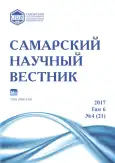Integration of interdisciplinary directions in the study of fractal geometry elements
- Authors: Rusanova I.A.1
-
Affiliations:
- Kazan (Volga Region) Federal University
- Issue: Vol 6, No 4 (2017)
- Pages: 246-251
- Section: 13.00.00 – Pedagogical Sciences
- URL: https://journals.rcsi.science/2309-4370/article/view/22364
- DOI: https://doi.org/10.17816/snv201764311
- ID: 22364
Cite item
Full Text
Abstract
This paper deals with the problem of integrating interdisciplinary areas in research activities that underlie developmental learning. In the conditions of new educational standards introduction deep system transformations of the whole educational process are supposed. The search for solutions to the problems of individualizing the educational route, polar motivation, increasing interest in physics and mathematics lead to the need to design individual methods of pedagogical activity, to implement new approaches and technologies in the natural science cycle of consistent development of holistic research activities, mastering the stages and methods of scientific knowledge. One of the opportunities for the formation of educational and cognitive activity and creative potential in the study of Physics and Mathematics is to study the elements of fractal geometry for analyzing the complex structure of processes of various physical nature, in view of the fact that today there is a large number of problems in Physics, Chemistry, Biology, Geology and Economics, where the fractal structure is the main characteristic of the system. Practical tasks on the construction of fractal sets with the identification of the main signs of self-similarity and the possibility of their computer modeling are considered. Students of grades 9–11 and students of the university are given the task of creating their own images of fractals, investigating the fractality of coastal river lines, constructing self-similar figures according to the algorithm «Games in chaos» and studying the contracting affine transformations with obtaining various modifications (attractors) of the Serpinsky triangle. The results obtained enable them to conclude that simple mathematical rules can generate self-similar formations with respect to nonlinear transformations, and argue that simple rules can be at the heart of complex structures and processes.
Full Text
##article.viewOnOriginalSite##About the authors
Inna Aleksandrovna Rusanova
Kazan (Volga Region) Federal University
Author for correspondence.
Email: irusanova@yandex.ru
senior lecturer of General Physics Department
Russian Federation, KazanReferences
- Лукьянова А.В. Модель формирования информационной компетентности учащихся при обучении физике в основной школе // Ярославский педагогический журнал. 2014. Т. 2, № 3. С. 26-30.
- Эльконин Б.Д. Понятие компетентности с позиции развивающего обучения // Современные подходы к компетентностно-ориентированному образованию: мат-лы семинара. Самара: Профи, 2001. С. 4-8.
- Коган Л.Н., Ханова О.В. Культура в условиях НТР. Саратов: Изд. ун-та, 1987. 153 с.
- Давыдов В.В. Виды обобщения в обучении: Логико-психологические проблемы построения учебных предметов. М.: Педагогическое общество России. 2000. 480 с.
- Межпредметные связи естественно-математических дисциплин: пособие для учителей / под ред. В.Н. Федоровой. М.: Просвещение, 1980. 208 с.
- Стародубцев В.А. Лабораторный практикум по курсу физики как проектная обучающая среда // Вестник ТГПУ. 2012. Т. 4, № 119. С. 151-154.
- Бабкин А.А. Фрактальная геометрия как средство ознакомления с новыми понятиями современной математики // Задачи в обучении математике: теория, опыт, инновации: мат-лы всерос. науч.-практ. конф. Вологда: Русь, 2007. 1215 с.
- Секованов В.С. Методическая система формирования креативности студентов университета в процессе обучения фрактальной геометрии. Кострома: Изд-во КГУ, 2006. 279 с.
- Павлов А.Н., Анищенко В.С. Мультифрактальный анализ сложных сигналов // Успехи физических наук. 2007. № 177 (8). С. 859-876.
- Русанова И.А. Проектирование индивидуальных методов педагогической деятельности на уроках физики // Современное образование: Актуальные вопросы, достижения и инновации. Пенза: МЦНС «Наука и просвещение», 2016. С. 119-132.
- Лухнева О.Ф., Балханов В.К. Временная динамика фрактальной размерности дельты р. Селенги // Нелинейный мир. 2007. Т. 5, № 10-11. С. 712-715.
- Дёмин А.Ю. Основы компьютерной графики: учебное пособие. Томск: Изд-во Томского политехнического университета, 2011. 191 с.
- Божокин С.В., Паршин Д.А. Фракталы и мультифракталы. Ижевск: НИЦ «Регулярная и хаотическая динамика», 2001. 128 с.
- Перерва Л.М., Юдин В.В. Фрактальное моделирование: учебное пособие / под общ. ред. В.Н. Гряника. Владивосток: Изд-во ВГУЭС, 2007. 186 с.
Supplementary files










